
Bonnet (headgear)
Encyclopedia
Bonnets are a variety of headgear
for both sexes, which have in common only the absence of a brim. Bonnet derives from the same word in French
, where it originally indicated a type of material. In the 21st century, only a few kinds of headgear are still referred to as bonnets, most commonly those worn by babies and Scottish soldiers.
.
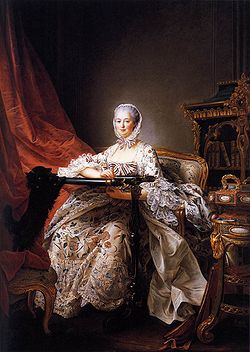 In the mid-18th century "house bonnets" worn by women and girls were generally brimless headcoverings which were secured by tying under the chin, and which covered no part of the forehead. They were worn indoors, to keep the hair tidy, (illustration, left) and outdoors, to keep dust out of the hair. With hairstyles becoming increasingly elaborate after 1770, the "calash" bonnet was worn outdoors to protect the hair from wind and weather: a hood of silk or black taffeta stiffened with whalebone or arched cane battens, collapsible like a fan or the calash top of a carriage, they were fitted with ribbons to allow them to be held secure in a gale.
In the mid-18th century "house bonnets" worn by women and girls were generally brimless headcoverings which were secured by tying under the chin, and which covered no part of the forehead. They were worn indoors, to keep the hair tidy, (illustration, left) and outdoors, to keep dust out of the hair. With hairstyles becoming increasingly elaborate after 1770, the "calash" bonnet was worn outdoors to protect the hair from wind and weather: a hood of silk or black taffeta stiffened with whalebone or arched cane battens, collapsible like a fan or the calash top of a carriage, they were fitted with ribbons to allow them to be held secure in a gale.  In Paris during the 1780s, light, unstructured bonnets were fashionable (illustration, right): Mme de Pezé's is of gauze with a border of gold threads, while Mme de Rouget is even more informally coiffed à la Turque, with a loose turban of striped silk.
In Paris during the 1780s, light, unstructured bonnets were fashionable (illustration, right): Mme de Pezé's is of gauze with a border of gold threads, while Mme de Rouget is even more informally coiffed à la Turque, with a loose turban of striped silk.
From Waterloo, more structured fashionable bonnets made by milliners rapidly grew larger. A plate in La Belle Assemblée
1817 showed a
This was specified as a "carriage dress", with the understanding that when taking the air in an open carriage, the bonnet provided some privacy—such a bonnet was in fact an invisible in Paris (caricature below)—and prevent wind-chapping, with its connotations of countrified rude health. Straw was available again after 1815: the best straw bonnet
s came from Leghorn
. As a bonnet developed a peak, it would extend from the entire front of the bonnet, from the chin over the forehead and down the other side of the face. Some styles of bonnets between ca 1817 and 1845 had a large peak which effectively prevented women from looking right or left without turning their heads: a "coal-scuttle" or "poke" bonnet. Others had a wide peak which was angled out to frame the face. In the 1840s it might be crimped at the top to frame the face in a heart shape. As the bonnet became more complicated, under it might be worn a lace cornette to hold the hair in place.
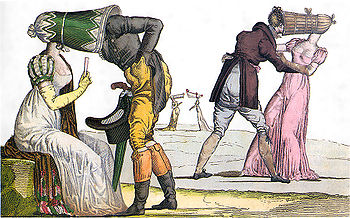 Bonnets remained one of the most common types of headgear worn by women throughout most of the 19th century. For a widow, a bonnet was de rigueur. Silk bonnets, elaborately pleated and ruched, were worn outdoors, or in public places like shops, galleries, churches, and during visits to acquaintances.
Bonnets remained one of the most common types of headgear worn by women throughout most of the 19th century. For a widow, a bonnet was de rigueur. Silk bonnets, elaborately pleated and ruched, were worn outdoors, or in public places like shops, galleries, churches, and during visits to acquaintances.
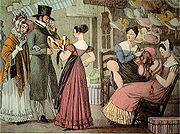 Under the French Second Empire, parasols took the place of protection from sun, and bonnets became smaller and smaller, until they could only be held on the head with hatpins. As hats came back into style, bonnets were increasingly worn by women who wanted to appear modest in public, with the result that bonnets accumulated connotations of dowager wear and dropped from fashion except on the prairies.
Under the French Second Empire, parasols took the place of protection from sun, and bonnets became smaller and smaller, until they could only be held on the head with hatpins. As hats came back into style, bonnets were increasingly worn by women who wanted to appear modest in public, with the result that bonnets accumulated connotations of dowager wear and dropped from fashion except on the prairies.
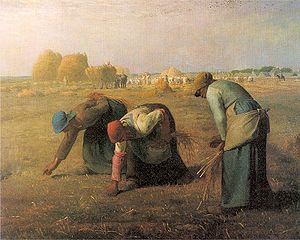 Most middle-class women in the 19th century would have had at least two bonnets, one suitable for summer weather, often made from straw, and one made from heavier fabric for winter wear. This is where the tradition of an Easter bonnet
Most middle-class women in the 19th century would have had at least two bonnets, one suitable for summer weather, often made from straw, and one made from heavier fabric for winter wear. This is where the tradition of an Easter bonnet
originated, when women would switch from their winter bonnet to their summer bonnet. Wealthier women would have many bonnets, suitable for different occasions.
In some religious groups it has been customary for women to wear bonnets. This was the case among the Friends (Quakers)
until well into the 20th century, and is still the case among the Old Order Mennonites and the Amish
. Bonnets were adopted by The Salvation Army as part of uniform regalia for women. Initially, bonnets were introduced as protection for women soldiers and were reinforced with black tar to turn them into helmets. Later versions were smaller when there was no longer any need for protection. The bonnet has now been replaced with a bowler style hat.
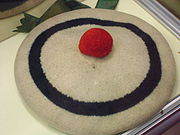
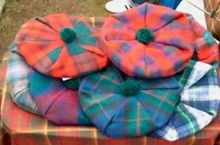 The word "bonnet" for male headgear was generally replaced in English by cap
The word "bonnet" for male headgear was generally replaced in English by cap
before 1700, except in Scotland
, where it remains in use, now especially for military headgear, like the Feather bonnet
(not to be confused with those worn by Native Americans
, for which "bonnet" was also used), Glengarry
, Kilmarnock and Balmoral
. The Tudor bonnet
remains a term for a component of the academic regalia of some universities, and is not unlike the common male bonnet of the 16th century.
"Bonnet" is also the term for the puffy velvet fabric inside the coronet
of some male ranks of nobility, and "the affair of the bonnets" was a furious controversy in the France of Louis XIV
over the mutual courtesies due between the magistrates of the Parlement de Paris and the Dukes of France.
The chile pepper Scotch bonnet was named for its resemblance to a bonnet worn by men in Scotland in the past, as it had a pom pom at the top which indicates the difference form the men's bonnet and women's bonnet.
The term is uncommon with Québécois
who prefer the term tuque
to designate those hats.
Headgear
Headgear, headwear or headdress is the name given to any element of clothing which is worn on one's head.Headgear serve a variety of purposes:...
for both sexes, which have in common only the absence of a brim. Bonnet derives from the same word in French
French language
French is a Romance language spoken as a first language in France, the Romandy region in Switzerland, Wallonia and Brussels in Belgium, Monaco, the regions of Quebec and Acadia in Canada, and by various communities elsewhere. Second-language speakers of French are distributed throughout many parts...
, where it originally indicated a type of material. In the 21st century, only a few kinds of headgear are still referred to as bonnets, most commonly those worn by babies and Scottish soldiers.
Babies
The most common kind of bonnet worn today is a soft headcovering for babies. They are shaped similarly to the kind of bonnets women used to wear, that is they cover the hair and ears, but not the forehead. See also CoifCoif
A coif is a close fitting cap that covers the top, back, and sides of the head.- History :Coifs were worn by all classes in England and Scotland from the Middle Ages to the early seventeenth century .Tudor and earlier coifs are usually made of unadorned white linen and tied under...
.
Women


From Waterloo, more structured fashionable bonnets made by milliners rapidly grew larger. A plate in La Belle Assemblée
La Belle Assemblée
La Belle Assemblée was a British women's magazine published from 1806 to 1837, founded by John Bell ....
1817 showed a
- "Bonnet of vermillion-coloured satin, embossed with straw, ornamented slightly with straw-coloured ribbands, and surmounted by a bouquet formed of a full blown damask rose and buds, with ears of ripe corn. This ornament is partially placed on one side: the edge of the bonnet finished by blond [lace] laid on strait."
This was specified as a "carriage dress", with the understanding that when taking the air in an open carriage, the bonnet provided some privacy—such a bonnet was in fact an invisible in Paris (caricature below)—and prevent wind-chapping, with its connotations of countrified rude health. Straw was available again after 1815: the best straw bonnet
Straw hat
A straw hat is a brimmed hat that is woven out of straw or reeds. The hat is designed to protect the head from the sun and against heatstroke, but straw hats were also used in fashion and as a decorative element of a uniform.- Manufacture :...
s came from Leghorn
Livorno
Livorno , traditionally Leghorn , is a port city on the Tyrrhenian Sea on the western edge of Tuscany, Italy. It is the capital of the Province of Livorno, having a population of approximately 160,000 residents in 2009.- History :...
. As a bonnet developed a peak, it would extend from the entire front of the bonnet, from the chin over the forehead and down the other side of the face. Some styles of bonnets between ca 1817 and 1845 had a large peak which effectively prevented women from looking right or left without turning their heads: a "coal-scuttle" or "poke" bonnet. Others had a wide peak which was angled out to frame the face. In the 1840s it might be crimped at the top to frame the face in a heart shape. As the bonnet became more complicated, under it might be worn a lace cornette to hold the hair in place.



Easter bonnet
An Easter Bonnet represents the tail-end of a tradition of wearing new clothes at Easter, in harmony with the renewal of the year and the promise of spiritual renewal and redemption....
originated, when women would switch from their winter bonnet to their summer bonnet. Wealthier women would have many bonnets, suitable for different occasions.
In some religious groups it has been customary for women to wear bonnets. This was the case among the Friends (Quakers)
Religious Society of Friends
The Religious Society of Friends, or Friends Church, is a Christian movement which stresses the doctrine of the priesthood of all believers. Members are known as Friends, or popularly as Quakers. It is made of independent organisations, which have split from one another due to doctrinal differences...
until well into the 20th century, and is still the case among the Old Order Mennonites and the Amish
Amish
The Amish , sometimes referred to as Amish Mennonites, are a group of Christian church fellowships that form a subgroup of the Mennonite churches...
. Bonnets were adopted by The Salvation Army as part of uniform regalia for women. Initially, bonnets were introduced as protection for women soldiers and were reinforced with black tar to turn them into helmets. Later versions were smaller when there was no longer any need for protection. The bonnet has now been replaced with a bowler style hat.
Men


Cap
A cap is a form of headgear. Caps have crowns that fit very close to the head and have no brim or only a visor. They are typically designed for warmth and, when including a visor, blocking sunlight from the eyes...
before 1700, except in Scotland
Scotland
Scotland is a country that is part of the United Kingdom. Occupying the northern third of the island of Great Britain, it shares a border with England to the south and is bounded by the North Sea to the east, the Atlantic Ocean to the north and west, and the North Channel and Irish Sea to the...
, where it remains in use, now especially for military headgear, like the Feather bonnet
Feather bonnet
The feather bonnet is a type of military headdress used mainly by the Scottish Highland infantry regiments of the British Army from about 1763 until the outbreak of World War I. It is now mostly worn by pipers and drummers in various bands throughout the world...
(not to be confused with those worn by Native Americans
War bonnet
Feathered war bonnets were worn by honored Plains Indian men, sometimes into battle, but most often for ceremonial occasions, and were seen as items of great spiritual and magical importance...
, for which "bonnet" was also used), Glengarry
Glengarry
The glengarry bonnet is a traditional boat-shaped hat without a peak made of thick-milled woollen material with a toorie on top, a rosette cockade on the left, and ribbons hanging down behind...
, Kilmarnock and Balmoral
Balmoral bonnet
The Balmoral is a traditional Scottish hat that can be worn as part of formal or informal Highland dress. Dating back to at least the 16th century, it takes the form of a knitted, soft wool cap with a flat crown...
. The Tudor bonnet
Tudor bonnet
A Tudor bonnet is a traditional soft round cap, with a tassel hanging from a cord encircling the puggaree of the hat...
remains a term for a component of the academic regalia of some universities, and is not unlike the common male bonnet of the 16th century.
"Bonnet" is also the term for the puffy velvet fabric inside the coronet
Coronet
A coronet is a small crown consisting of ornaments fixed on a metal ring. Unlike a crown, a coronet never has arches.The word stems from the Old French coronete, a diminutive of coronne , itself from the Latin corona .Traditionally, such headgear is – as indicated by the German equivalent...
of some male ranks of nobility, and "the affair of the bonnets" was a furious controversy in the France of Louis XIV
Louis XIV of France
Louis XIV , known as Louis the Great or the Sun King , was a Bourbon monarch who ruled as King of France and Navarre. His reign, from 1643 to his death in 1715, began at the age of four and lasted seventy-two years, three months, and eighteen days...
over the mutual courtesies due between the magistrates of the Parlement de Paris and the Dukes of France.
The chile pepper Scotch bonnet was named for its resemblance to a bonnet worn by men in Scotland in the past, as it had a pom pom at the top which indicates the difference form the men's bonnet and women's bonnet.
Modern French
The term "Bonnet" remains in use in modern European French (France, Belgium, Switzerland...). Regarding winter headgear, it is mostly used as common denomination for knitted beanies or ski hats.The term is uncommon with Québécois
Quebec French
Quebec French , or Québécois French, is the predominant variety of the French language in Canada, in its formal and informal registers. Quebec French is used in everyday communication, as well as in education, the media, and government....
who prefer the term tuque
Tuque
A – variously known as a knit hat or stocking cap among other names – is a knitted cap, originally of wool though now often of synthetic fibers, that is designed to provide warmth in winter...
to designate those hats.
External links
- Jonathan Walford, "Women's fashion headwear"
- Mixed Fashion Plates 1800-1900, with original descriptive captions

